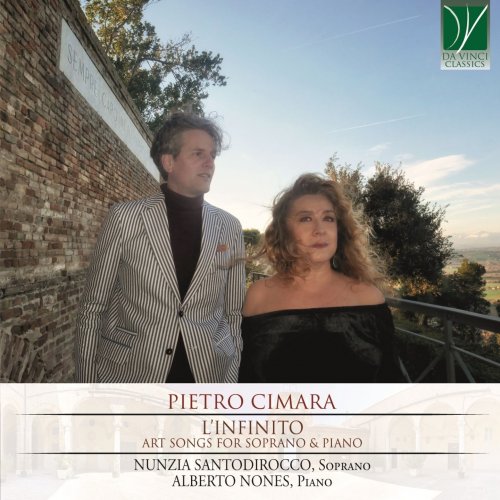
Nunzia Santodirocco & Alberto Nones - Pietro Cimara: L’Infinito, Art Songs for Soprano & Piano (2019)
BAND/ARTIST: Nunzia Santodirocco, Alberto Nones
- Title: Pietro Cimara: L’Infinito, Art Songs for Soprano & Piano
- Year Of Release: 2019
- Label: Da Vinci Classics
- Genre: Classical
- Quality: FLAC (tracks)
- Total Time: 43:23
- Total Size: 165 MB
- WebSite: Album Preview
Tracklist:
1. L'Infinito (03:39)
2. Nostalgia (02:42)
3. Paranzelle (01:09)
4. Fiocca la neve (02:25)
5. Notte d'estate (02:46)
6. Stelle chiare (03:19)
7. O dolce notte! (02:59)
8. Paesaggio (03:15)
9. Visione marina (02:45)
10. Ondina (01:19)
11. Le campane di Malines (02:38)
12. Adorazione (02:59)
13. Mattinata (02:55)
14. Stornello (02:42)
15. Dormi! (02:44)
16. Presso una fontana (02:59)
1. L'Infinito (03:39)
2. Nostalgia (02:42)
3. Paranzelle (01:09)
4. Fiocca la neve (02:25)
5. Notte d'estate (02:46)
6. Stelle chiare (03:19)
7. O dolce notte! (02:59)
8. Paesaggio (03:15)
9. Visione marina (02:45)
10. Ondina (01:19)
11. Le campane di Malines (02:38)
12. Adorazione (02:59)
13. Mattinata (02:55)
14. Stornello (02:42)
15. Dormi! (02:44)
16. Presso una fontana (02:59)
Pietro Cimara was born in 1887 in Rome, where he studied composition at the Liceo musicale di Santa Cecilia with Ottorino Respighi, “my Master” to whom he would dedicate Notte d’estate, and died in Milan in 1967. But aside from traces of information to be found in a few sources, he is a figure wrapped in mystery. Son of Giovanna Putti and Giuseppe, it is not known how he approached music; it is certain that he also studied with teachers like Stanislao Falchi and Alessandro Bustini (who will also teach Petrassi and Maderna), complementing his studies with a degree in law. He began working at the Costanzi theater in Rome first as a substitute and then as a conductor, also distinguishing himself (especially within aristocratic circles) as the composer of songs. A decisive moment was the preparation in that same theater of Il Trittico by Puccini, whose triumphal premiere was in 1919, and on which occasion the young Cimara collaborated not only with Puccini, but also with Toscanini. In the following years he was assistant and collaborator with the main conductors of the time, such as Tullio Serafin and Vittorio Gui (a composer of art songs, too). Gui, on the occasion in which he invited Cimara to conduct La traviata at Covent Garden many years later, wrote that the invitation was due to a man who usually worked behind the scenes and must see his talent openly recognized. In the meantime, Cimara’s reputation of “unsurpassed accompanist” had brought him to work with both the spinto soprano Eva Tetrazzini-Campanini, and her more famous sister Luisa Tetrazzini, coloratura soprano whom he accompanied in a world tour in ’19 -’20, in which the programs presented some compositions of Cimara, too. A 1922 document testifies his qualities at the piano. It is a CBS/Odyssey LP of the “legendary performances” series, which we could listen to thanks to the ICBSA State Audiovisual Archive in Rome. It features bass Salvatore Baccaloni who – besides declaiming some Sonetti romaneschi by Trilussa over a mesmerizing and witty piano improvisation – interprets various arias and songs from his repertoire, as well as Cimara’s Fiocca la neve (transposed in C minor from the G minor of the printed editions, and with double bass in the last two chords) with the composer at the piano. Cimara demonstrates here not only the dynamic and agogic command of a great conductor, but also the palette of sounds of a great pianist. In that whirling of concerts and conducting, composition was doomed to remain in a niche. In 1928 Cimara began working at the Metropolitan in New York, where he conducted an impressive number of operas and concerts with the foremost singers of the day, really without sparing himself until 1958, when, conducting La forza del destino (of course!), he fell from the podium in the orchestra pit and was taken to the hospital, while violinist Walter Hagen stepped to the podium to complete the scene; quite a coupe de théâtre, one might think, but it was a serious heart attack, after which he could not resume working again. Since his untiring commitment as a conductor had almost invariably been in roles of preparation and second performances, Cimara went into obscurity. His character had always led in that direction, and perhaps he had become even more reserved after the early death of his only daughter. Melody M Rich, the author of a doctoral thesis which is one of the few sources of information on Cimara’s life and works to-day, hypothesized that the mysterious dedication of Nostalgia “to …” could have been meant for her daughter, and we like to believe it too. A shy person, jealous of his affections, Cimara loved and served music with total dedication but without outcry. It is an even greater and rarer privilege, therefore, to contribute to bringing his music and figure back to light. The music is so heartfelt and authentically inspired, in our opinion, that perhaps the composer himself was torn between cultivating and giving it to the public, or keeping it in a drawer or at least just within small circles. Infinite in the sense of unfinished or incomplete, one would seem to have to conclude.
Year 2019 | Classical | FLAC / APE
As a ISRA.CLOUD's PREMIUM member you will have the following benefits:
- Unlimited high speed downloads
- Download directly without waiting time
- Unlimited parallel downloads
- Support for download accelerators
- No advertising
- Resume broken downloads


